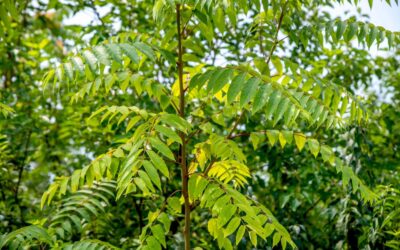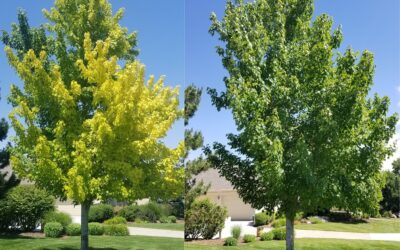The honey locust is a North American native that grows naturally in the moist soils of river valleys from the Appalachians west to the eastern edge of the Great Plains and Central Texas. It’s a fast-growing, rounded tree that tops out between 65-100 feet.
Lacy Leaflets, Colorful Flowers and Sweet-Smelling Seed Pods
Honey locust leaves grow with 20-30 narrow leaflets alternating on 6-8 inch stalks giving a delicate, lacy look to the tree. They are dark green in summer and turn brilliant yellow in fall. Small yellow-green flowers grow inconspicuously on spikes in the spring, but can attract pollinators such as bees and butterflies. Native trees produce long, inch-wide seed pods that attract squirrels and browsing wildlife and have large thorns that make wild stands of the trees popular shelter for many animals. The seed pods can have a strong, sweet aroma when they ripen and fall.
Dense, Rot-Resistant Wood
Honey locust wood is dense, easily worked and rot resistant, making it popular for use as fence posts and railroad ties as well as in furniture making, wood pallets, tool handles and as fuel. Native Americans used honey locust in medicinal compounds, and it still has important pharmacological uses today.
Cultivated Varieties Suit Colorado Conditions and Landscapes
Cultivars of the honey locust have been developed that have neither thorns nor seed pods, and have become popular as ornamental landscape trees along Colorado’s Front Range as a result. It tolerates urban conditions, compacted soil, road salt, alkaline soil, heat and drought, but must be kept watered, including winter dry spells. It requires full sun and pruning the lower limbs will encourage tall, upright growth.
Established honey locust trees are generally maintenance-free and have few significant pests. But dry winters, hail damage, and late spring freezes have stressed some trees in Colorado lately. They’re strong, hardy, though, and pruning of dead wood before fall may be all that it takes to have a healthy, attractive tree the following spring.
If you’re considering adding a honey locust to your landscape, or have one that needs maintenance, call us at 303-623-8733.



